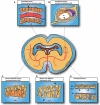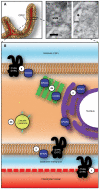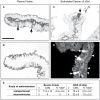Barrier mechanisms in the developing brain
- PMID: 22479246
- PMCID: PMC3314990
- DOI: 10.3389/fphar.2012.00046
Barrier mechanisms in the developing brain
Abstract
The adult brain functions within a well-controlled stable environment, the properties of which are determined by cellular exchange mechanisms superimposed on the diffusion restraint provided by tight junctions at interfaces between blood, brain and cerebrospinal fluid (CSF). These interfaces are referred to as "the" blood-brain barrier. It is widely believed that in embryos and newborns, this barrier is immature or "leaky," rendering the developing brain more vulnerable to drugs or toxins entering the fetal circulation from the mother. New evidence shows that many adult mechanisms, including functionally effective tight junctions are present in embryonic brain and some transporters are more active during development than in the adult. Additionally, some mechanisms present in embryos are not present in adults, e.g., specific transport of plasma proteins across the blood-CSF barrier and embryo-specific intercellular junctions between neuroependymal cells lining the ventricles. However developing cerebral vessels appear to be more fragile than in the adult. Together these properties may render developing brains more vulnerable to drugs, toxins, and pathological conditions, contributing to cerebral damage and later neurological disorders. In addition, after birth loss of protection by efflux transporters in placenta may also render the neonatal brain more vulnerable than in the fetus.
Keywords: blood–CSF barrier; blood–brain barrier; cerebrospinal fluid; endothelial cell transport; epithelial cell transport; fetus; newborn.
Figures







Similar articles
-
The biological significance of brain barrier mechanisms: help or hindrance in drug delivery to the central nervous system?F1000Res. 2016 Mar 10;5:F1000 Faculty Rev-313. doi: 10.12688/f1000research.7378.1. eCollection 2016. F1000Res. 2016. PMID: 26998242 Free PMC article. Review.
-
Barrier mechanisms in the brain, II. Immature brain.Clin Exp Pharmacol Physiol. 1999 Feb;26(2):85-91. doi: 10.1046/j.1440-1681.1999.02987.x. Clin Exp Pharmacol Physiol. 1999. PMID: 10065326 Review.
-
Barriers in the developing brain and Neurotoxicology.Neurotoxicology. 2012 Jun;33(3):586-604. doi: 10.1016/j.neuro.2011.12.009. Epub 2011 Dec 19. Neurotoxicology. 2012. PMID: 22198708 Review.
-
Recent Developments in Understanding Barrier Mechanisms in the Developing Brain: Drugs and Drug Transporters in Pregnancy, Susceptibility or Protection in the Fetal Brain?Annu Rev Pharmacol Toxicol. 2019 Jan 6;59:487-505. doi: 10.1146/annurev-pharmtox-010818-021430. Epub 2018 Sep 5. Annu Rev Pharmacol Toxicol. 2019. PMID: 30183506 Review.
-
Blood-brain, blood-cerebrospinal fluid and cerebrospinal fluid-brain barriers in a marsupial (Macropus eugenii) during development.J Physiol. 1988 Sep;403:367-88. doi: 10.1113/jphysiol.1988.sp017254. J Physiol. 1988. PMID: 3075668 Free PMC article.
Cited by
-
Tight junctions in the blood-brain barrier promote edema formation and infarct size in stroke - Ambivalent effects of sealing proteins.J Cereb Blood Flow Metab. 2021 Jan;41(1):132-145. doi: 10.1177/0271678X20904687. Epub 2020 Feb 13. J Cereb Blood Flow Metab. 2021. PMID: 32054373 Free PMC article.
-
Early Sites of Virus Replication After Oral SIVmac251 Infection of Infant Macaques: Implications for Pathogenesis.AIDS Res Hum Retroviruses. 2018 Mar;34(3):286-299. doi: 10.1089/AID.2017.0169. Epub 2018 Jan 17. AIDS Res Hum Retroviruses. 2018. PMID: 29237287 Free PMC article.
-
Connexin Channels at the Glio-Vascular Interface: Gatekeepers of the Brain.Neurochem Res. 2017 Sep;42(9):2519-2536. doi: 10.1007/s11064-017-2313-x. Epub 2017 Jun 20. Neurochem Res. 2017. PMID: 28634726 Review.
-
Border-Associated Macrophages: From Embryogenesis to Immune Regulation.CNS Neurosci Ther. 2024 Nov;30(11):e70105. doi: 10.1111/cns.70105. CNS Neurosci Ther. 2024. PMID: 39496482 Free PMC article. Review.
-
Blood-brain barrier structure and function and the challenges for CNS drug delivery.J Inherit Metab Dis. 2013 May;36(3):437-49. doi: 10.1007/s10545-013-9608-0. Epub 2013 Apr 23. J Inherit Metab Dis. 2013. PMID: 23609350 Review.
References
LinkOut - more resources
Full Text Sources
Other Literature Sources

